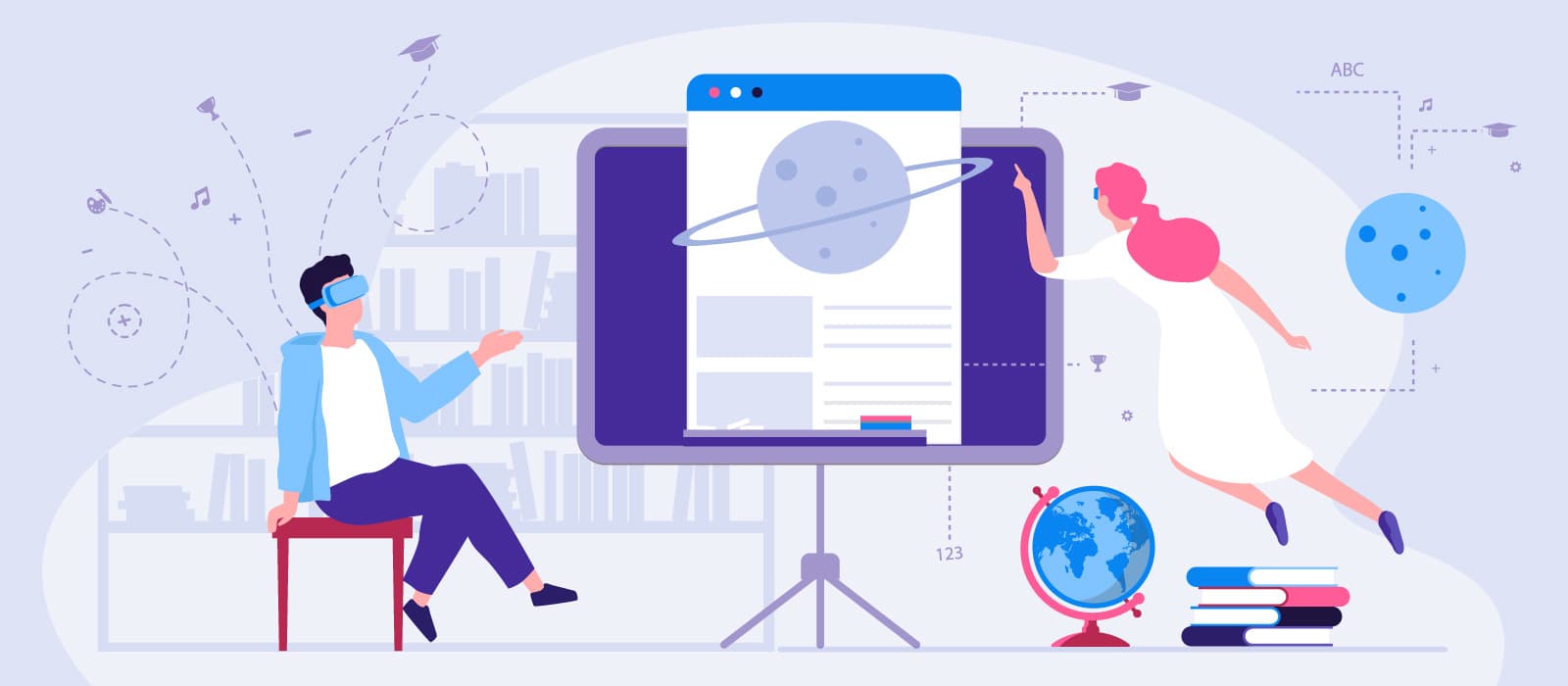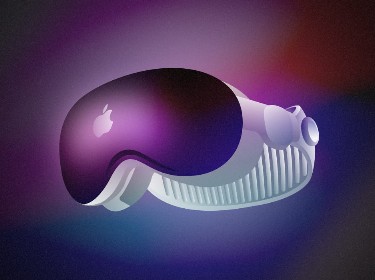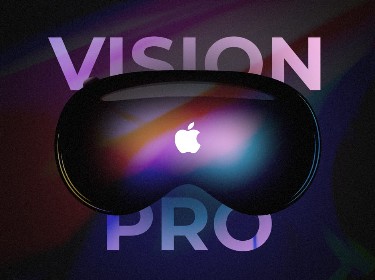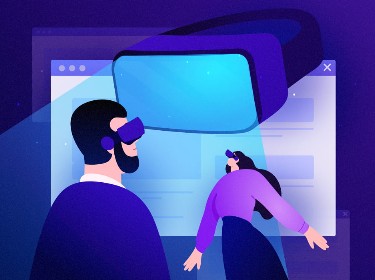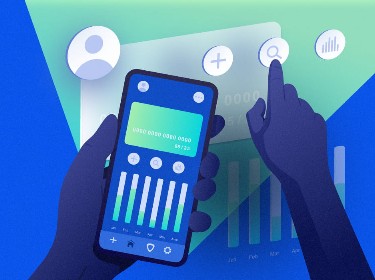With information now so readily available thanks to powerful search engines, a new wave of education tools - virtual and augmented reality in particular - are putting a greater emphasis on student engagement, learning by doing, and a broader understanding of complex subjects.
The technological developments of the past 15 years have made a huge difference to contemporary society, transforming education and training. Computers and the Internet allow teachers and students to work, study, and gain information in ways that were once unthinkable.
One of the latest and, at the same time, most exciting technological developments in education is the use of virtual reality (VR) and augmented reality (AR) to empower learning. Virtual reality and augmented reality allow users to interact with computer-simulated environments, real or imagined. VR also enables users to experience visual, auditory, tactile, smell, and taste inputs in a three-dimensional space. According to the statistics, the global AR, VR, and MR market is expected to rise close to $300 billion by 2024, which surely looks very promising and implies that we’re yet to see even greater innovations and developments in multiple spheres, including education.
The use of VR and AR helps address some of the fundamental issues in modern education. These include the shift from fact retention methods of teaching towards more interactive ones and the search for new ways to engage students.
VR and AR technologies have much to offer when it comes to getting students interested in the learning material. The virtual world of infinite possibilities enables the creation of educational and training content that leads to a greater understanding of advanced concepts. Equally, VR and AR aid learning by allowing active participation during the lessons as well as helping to personalize education and improve the learner’s creativity.
Read on to find out more about VR/AR in education, its benefits and market outlook, top applications, and the companies already developing these technologies.
How do we learn today?
Most people would agree that the majority of education and training systems around the world need improving. In the past, most educational tools and technologies focused on enabling and improving access to information. Books led the revolution before digital technologies such as computers, tablets, smartphones, smart whiteboards, and the Internet itself stole the scene.
Today, digital technologies are dominant amongst education tools, with e-books and powerful search engines at the forefront. Students can find facts and information effortlessly. Answers to so many questions are just a few clicks away.
Despite easier access to knowledge, the way we learn today has some key challenges.
Teaching methods are still about fact retention. Nowadays, most teaching methods concentrate on presenting students with facts about a subject. Students have access to information, but crucially this is not the same as learning.
Information is often difficult to comprehend. Receiving a lot of information in a short time can be overwhelming for learners. They get disengaged and bored.
Lack of engagement outside and inside the classroom. The education of an individual depends considerably on the learning experiences outside as well as inside the classroom. Current teaching tools and methods are not managing to motivate students to continue learning after the active teaching period is over.
A solution to these issues lies in the exploration of new digital technologies and their inclusion in the school and training curricula. Among the novel digital technologies, AR/VR assisted education is attracting the most attention.
Get more insights into this VR real estate platform used for generating 360° virtual tours
What is VR/AR assisted learning?
![]()
Virtual reality technology makes use of specialized headsets and software to place the user into a virtual environment and provide a simulated experience. Some of the best headsets on the market are Oculus Quest 2, HTC Vive Cosmos, and Valve Index. Smartphone-based low-cost headsets such as Cardboard VR are particularly suited to educational purposes.
Not all virtual environments are the same, of course. Virtual reality is a digital-only environment, while augmented reality superimposes digital information on real-world elements.
Novel education tools and methods leverage VR/AR technologies to create immersive and blended environments in which users can interact with objects and systems, including those that are too small, too large, or perhaps too dangerous to experience in real life. With virtual reality, users can assemble, disassemble, manipulate, and modify objects and environments in ways that have never previously been possible.
As VR/AR technology is advancing, educators have started to incorporate it into their teaching routines. In the classroom, teachers use AR apps to animate science textbooks and study flashcards to make the experience more enjoyable for the student. Some teachers also use AR to enhance homework by incorporating interactive puzzles and quizzes for their students.
Another effective way in which teachers have begun to use augmented reality education is through AR Lab classes, which allow students to interact with 3D models of humans, animals, and plants.
Besides classroom use, many enterprises have begun to use VR/AR education to train employees. Professional training curricula are being virtualized for easier comprehension and improved safety. VR/AR education is also becoming more and more popular among museums and other history-oriented educators. They use these tools to provide their audiences with entertaining, interactive learning experiences.
We have also started seeing social experiences and training classes as a part of the virtual reality classroom. They give people a platform to interact and collaborate in virtual environments, once again with the aim of enhancing the learning process. Learners can achieve ‘impossible’ feats, such as journeying inside a brain cell or traveling back in time.
Check out this VR platform for hotel & resort owners that helps showcase locations in 360° virtual tours with the Oculus Go headset
Benefits of VR/AR in education and training
The benefits of virtual reality and augmented reality in education and training are many. As we have suggested, both VR and AR can enhance learning and increase learner engagement. Virtual reality in education transforms the way educational content is delivered. It creates a fact-based virtual world and allows users to see and interact with it in three-dimensional space. Virtual and augmented reality can help solve the biggest problems of education today through innovative teaching methods and differentiated content.
Better student engagement
VR/AR in education helps students become more interested in learning about a topic, thanks to the use of interactive 3D models. Instead of pure fact presentation, virtual reality education software can gamify the learning experience. It can visualize the information so that it can be better understood; it can also offer challenges that will motivate the learner to engage with the content.
Students often become bored when learning about geology or history from a regular textbook. But they are far more likely to stay wide awake when their lessons involve a 3D model of a volcano or a historic battlefield.
Better understanding of advanced concepts
The process of understanding the taught topic is different for every student. For some students, it takes more time to grasp certain notions such as the physics of planetary motion or geological changes. An inability to visualize concepts slows the path to comprehension. VR/AR in education acts as a tool for gaining an accurate picture of unobservable and hard-to-understand ideas.
Aid learning by doing
Virtual reality in education and training can assist in practical learning by simulating real-world environments. Some jobs and professions require many hours of training to achieve proficiency. Nevertheless, real-world practice is often expensive or dangerous.
For example, it’s crucial that surgeons and pilots are given realistic and detailed training. Besides headsets and software, virtual reality makes use of haptic (touch-based) devices, resembling real-world objects, that can provide real-time feedback. Using VR, students get inspired to discover knowledge for themselves regardless of any operational limits.
Emotional reactions
Learning is a multi-dimensional experience involving our senses, our power of thought, and our ability to form memories and feel emotions. Learning effectiveness is directly proportional to the level of engagement of these elements. Virtual reality helps by sparking specific emotional reactions in students, adding a new layer to the lessons and making them more memorable.
Improving creativity
In addition to content consumption, VR/AR in education is useful for boosting creativity. Powerful tools such as Tvori, a storytelling tool that allows users to quickly and easily create animated projects through the use of virtual reality, can help spur the creativity of learners.
Personalizing education
The main reason behind many students’ struggles with education is the way the material is presented to them. Not all students have the same needs or comprehension levels. Incorporating virtual reality education in the classroom allows teachers to tailor lessons to the needs of the individual student. Whether that means allowing students to learn at their own pace, or letting teachers create personalized study guides for their students, the application of VR/AR can make the learning experience a uniquely individual one.
Creating a learning community
Another benefit of augmented reality programs in education is that students can use the technology to connect with peers and study together. Thus educators can help their students connect to a learning community in which they can help each other work through difficult concepts with the assistance of software applications. VR could be particularly useful for long-distance classrooms or online classrooms, where students tend not to benefit from the levels of connection and support that students in traditional classrooms enjoy.
Take a peek at this AR mobile app for Treadwater graphic novel for better gaming
VR/AR education statistics
VR and AR are transforming the education sector by creating new ways to teach and learn. The clearest advantage of VR is its ability to bring to life information from books and make education more exciting and engaging.
According to a Fortune BI report, the global virtual reality in education market size stood at USD 656.6 million in 2018. It is projected to reach 13,098.2 million USD by 2026, an annual growth rate of 42.9%.
The main market trends are telerobotics (operating robots from a distance), VR simulations of biological processes or historical events, and enhanced visualization of teaching and training materials.
The main market drivers for VR/AR in education are the high adoption rates of virtual learning environments, advances in the technology of VR headsets, and the many new partnerships in the corporate and education sectors.
Applications of VR/AR in education
![]()
Our virtual and augmented reality app development company shortlisted some of the most promising use cases of leveraging AR/VR technologies in education and training. Let’s take a closer look at each.
Virtual tools for real-world learning
The earliest and most common application of VR/AR in education is as a virtual tool for real-world learning. In general, learners remember far more about something through direct experience as opposed to just reading, seeing, or hearing about it. VR is applicable at all levels of education – from primary schools to universities. The key is setting up the virtual reality content so that it is appealing to the target audience.
Depending on the age of the students and the subject, VR lessons can put the focus on different areas:
- Geography: virtually visiting geographic locations and habitats.
- History: virtual recreation of historical sites.
- Science: virtual traveling into space, exploration of the human body, and safe experimentation with chemicals.
- Technology: a virtual tour of machines and engineering projects.
- Art and culture: attending cultural events in virtual reality and learning to paint, sculpt, or do pottery in VR.
- Architecture and design: the creation of architecture projects in virtual reality, and visits to celebrated buildings.
Online classroom
Online courses and online classrooms have proven to be ineffective means of learning. One of the main challenges is the high dropout rate. The most common reason for this is the lack of student engagement. VR classrooms, on the other hand, give students opportunities to raise their hands, ask questions organically, and feel more directly invested. VR education makes learning experiences social by allowing students to communicate with each other. Using avatars and mapped facial expressions, people can come together to discuss and collate information, and learn from one another.
Virtual field trips
With the help of VR field trips, students can visit places they have never seen before and which school expedition organizers could never, due to the cost, arrange in the real, physical world. Students can, for example, learn about spatial inequality in the classroom and then take a VR tour of Tokyo to get a sense of how people interact there.
Similarly, during a class about oceans and ecosystems, students can take a virtual swim through the coral reefs. With VR and AR, teachers are no longer limited by the classroom walls. VR lets students explore the world virtually, while AR brings abstract concepts to life, allowing teachers to guide students through collections of scenes and objects, and to point out interesting sites and artifacts along the way.
Special education
For people with physical disabilities studying and exploring the world through a VR headset is a great option. Both AR and VR increase motivation, facilitate interaction, develop cognitive skills, and improve short-term memory. Lessons become more enjoyable. The most profound effect lies in the improvement of communication skills, especially in students with hearing problems. For autistic students, VR seems to encourage social interaction.
For learning-disabled individuals, AR can improve vocabulary through gamification. In India, educators have created an interactive textbook that uses 3D images, audio clips, and videos to explain the text. VR has also been effectively used to tackle social anxiety, language deficiencies, attention deficit hyperactivity disorder (ADHD), physical or motor disability, cognitive deficits, dyslexia, and Down’s syndrome.
Training
VR is a practical solution for technical training fields like the military, engineering, or medical sectors. For example, the most significant challenge for medical students learning anatomy is understanding the body in three dimensions and seeing how different systems fit together. VR education can help overcome this problem.
Virtual reality simulations help students learn practical skills, and one of the benefits of training in this way is that students can learn from realistic scenarios without the risk of practicing an unfamiliar skill in an uncontrolled real-life situation.
Internships
Being exposed to different careers is an essential part of the learning process. Often, understanding what profession to choose is accomplished through internships. With the help of VR, students can imagine themselves in different roles and jobs. Career expeditions show what it is like to work in a field: students can explore a typical day on a job and get insights into what people think about their roles.
Game-based learning
Virtual reality will likely completely change the way games can be used for learning. Game-based learning works because it increases engagement and motivation, and virtual reality can take this to the next level. There is much that can be accomplished in a virtual environment that would not be possible in real life. Also, the process sticks in the memory: the visual and kinesthetic experiences in virtual worlds contribute to the learning ability of users.
Virtual labs
Science students need hands-on time in a lab to master the different skills and techniques they are taught in class. State-of-the-art labs, where hands-on STEM learning takes place, are often difficult to access and costly. VR technology offers a realistic lab experience that lets users perform experiments and practice skills in a fun and risk-free learning environment.
The VR labs have many opportunities not available in a regular lab, such as the ability to view life science at the molecular level, to examine scenarios that highlight the connection between the lab experience and the real world, and to speed up experiments so results can be seen faster.
Get more insights into AR and VR solutions in the fashion industry
Top companies working on education in virtual reality and augmented reality
![]()
zSpace
zSpace is continuing to make an impact in the VR/AR education space, standing out in their field thanks to a unique all-in-one AR/VR laptop with content that can be manipulated with a stylus pen. When used in classrooms, kids have access to zSpace glasses, which allow for individual and collaborative learning experiences. zSpace is present in over 800 school districts in North America, with over 1M users. Educators who have used the tool report higher levels of student interaction and engagement with the educational content.
Curiscope
Curiscope is a UK-based AR and VR startup that seeks to inspire curious kids across the globe to develop a love for science. The company offers nicely designed AR solutions that allow users to explore the world around them in ways never thought possible. Its first product, called Virtuali-Tee, has received the prestigious Gold Mom’s Choice and Gold Oppenheim Toy Portfolio Awards. The Virtuali-Tee by Curiscope is an Augmented Reality t-shirt for learning about the body. All you have to do is to point Curiscope’s free app (available on both iOS & Android) at the 100% cotton tee and learn about the human body in a totally unique way.
Nearpod
Nearpod is an organization aimed at transforming teaching by providing ready-to-teach K-12 lessons delivered through VR and interactive digital content. Nearpod offers several educational solutions, such as pre-made lessons that can sync to student devices, options to customize lessons, AR enhancements, and over 500 VR classes.
Merge
Merge Virtual Reality creates products and experiences targeted at kids aged ten and upwards. They want to create products that make kids smarter, more creative, and more collaborative. They offer innovative experiences for the classroom, for example, a Merge Cube. This is a hologram you can hold in your hand: it displays objects such as the human heart, an aquarium, or the solar system, and allows interaction with them.
With Merge EDU, science teachers can explain concepts more effectively, STEM programs can expand beyond the classroom, and schools can introduce powerful new educational technology. Merge designs durable products (such as brightly colored headsets made out of soft material), and their content and headsets will work with almost any smartphone.
VR Education
VR Education is a software company that provides educators with the tools they need to create their content in virtual classrooms. The ENGAGE platform, in particular, can simulate a lecture hall in VR—allowing educators to create specialized lessons and enabling people from all over the world to engage virtually in a multi-user environment.
The platform allows educators to build their content, use existing environments, and record or share sessions. The ENGAGE platform is currently free to use for social education and presentation purposes.
Google Expeditions Pioneer Program
Google Expeditions allows teachers to act as guides, leading their students on expeditions all over the world and even in space. Google Expeditions has expanded to encompass over 900 VR experiences, all available for classroom exploration. In the future, Google expects to provide students with the tools to create their own VR expeditions. This move will not only increase the amount of content available to other users but also teach students how to create immersive content and use editing software. Google has also added AR Expeditions, allowing students to use almost any Android or iOS device to make life-sized virtual objects appear in their classrooms.
Alchemy Immersive
Alchemy Immersive is creating unique immersive educational stories. For example, some stories allow viewers to follow in the footsteps of Charles Darwin across the Galapagos, deep dive beneath the Great Barrier Reef next to David Attenborough or descend from the International Space Station. What makes Alchemy VR stand out are the high-quality experiences they produce and the number of partners they have (including Google Expeditions), enabling them to produce engaging and educational experiences for all ages.
EON Reality
EON Reality is a US-based AR and VR company that specializes in academic and industry training solutions. In 2019, EON Reality launched the AVR Platform, a comprehensive AR/VR teaching and learning application that simplifies lesson creation, allowing anyone without coding knowledge to use AR and VR for learning. In September 2020, EON Reality rebranded the AVR Platform as EON-XR, reflecting the mixed reality modes available on the platform.
RegattaVR
RegattaVR is the operator of virtual reality training services intended to help organizations to bring about behavioral change and greater empathy. The company offers blended training services to complement VR/AR using multiple modalities such as online, classroom, games, self-study, video, animation, and performance support tools. RegattaVR enables users to apply formal methodologies to instructional design, user experience design, and data protocols to ensure efficient educational and training results.
Avantis Systems Ltd.
Avantis has been helping teachers to embed classroom technology for almost twenty years. During that time it has delivered its products to tens of thousands of schools. Driven by developing simple, effective, and innovative solutions to classroom challenges, Avantis now boasts a diverse portfolio of classroom-focused products and services that are in daily use by millions of students. With award-winning brands LearnPad, ClassCharge, and ClassConnect and the launch of the revolutionary ClassVR, Avantis is continually reinventing how technology is used within schools to support teachers in boosting engagement and simplifying the use of classroom technology.
Top examples of VR / AR in education
![]()
The adoption rate of VR in education and training is getting higher as more and more institutions are incorporating this technology into their curricula. The market outlook is prompting startups as well as established IT companies to launch hardware and software VR solutions for education and training purposes.
Discovery VR
Discovery VR is a virtual reality application that allows the viewing of exclusive 360-degree videos educational content about wild nature, environmental problems, space adventures, culture, and history. Teachers can use Discovery VR to assign the viewing of a video that aligns with the course content and can prepare questions and viewing guides, following them up with targeted discussions. Every time users explore the VR environment, they can focus their attention on a different aspect of the video. Multiple viewings, especially using a headset, will help students explore the content in a new way and spot more details each time they visit the VR world.
Arility
Arility is an AR app aimed at providing the basics of safety education to children. It enables kids to directly interact with AR characters in dangerous situations and encourages them to identify safer choices at their own pace. Teachers can rely on the real-time dashboard to effectively manage the class either as a whole or in small groups and get a special report card based on curriculum outcomes. Thanks to AR and 360°visuals functionalities, the Arility app makes teaching essential safety skills in the classroom easy and, crucially, engaging.
Orbulus
Orbulus is a virtual reality application that features 360-degree images from locations all over the world, from the Rockefeller Center and the Pyramids to the Sydney Opera House and the Northern Lights. The combination of static pictures and simple navigation allows users to explore world landmarks and even other planets such as Mars. Teachers can use Orbulus to augment the course content, with images of locations appearing in the lesson materials. The use of VR apps such as Orbulus will lead to higher student engagement and better memory development, via the inclusion of visual materials.
Nanome
Nanome is a VR app for the discovery and study of nanoworlds. The app allows users to manipulate atoms and design molecules in real-time and then study them in a target environment and modify them as desired. Nanome helps boost both learning and scientific research by freeing the brain from imagining and describing complex concepts. Nanome increases student engagement and comprehension using collaborative chemical design software in VR.
Unimersiv
Unimersiv is one of the largest platforms for VR education. The company creates a variety of VR content for schools about history, space, or human anatomy (tours of ancient Rome, the Acropolis of Athens and Stonehenge, or learning about dinosaurs in VR), as well as for corporate training.
Google Cardboard
Google Cardboard is a virtual reality platform developed by Google. Named for its fold-out cardboard viewer that holds a smartphone, the platform is a low-cost system that encourages the development of applications. Users can either build their viewer from simple, low-cost components using specifications published by Google or purchase a pre-manufactured one. To use the platform, users run Cardboard-compatible mobile apps on their phone, place it into the back of the viewer, and view content through the lenses.
View-Master
Mattel, in collaboration with Google, produced a VR version of View-Master. Similar to Cardboard, this VR headset uses smartphones, lenses, and a mobile app built using Cardboard SDK. View-Master Destinations offers users the experience of visiting famous places like the Statue of Liberty and Ellis Island in New York, the ancient Mayan city of Chichen Itza, or the Tower and Tower Bridge in London.
View-Master Space lets users explore our solar system, see spacecraft up close, learn new facts about space, trace constellations, and even compare planetary gravity through mini-games. View-Master Wildlife lets the user explore picturesque natural habitats and observe animals in, for example, the Australian Outback, the heart of Amazon, or the African Savanna.
Google Expeditions
Google Expeditions is an immersive education app that allows teachers and students to explore the world through over 1000 virtual-reality and 100 augmented-reality tours. Teachers and students can use mobile devices and VR viewers to virtually explore an art gallery or museum, swim underwater, or navigate outer space without leaving the classroom. As part of AR tours, teachers can use mobile devices to bring objects into their classrooms so that students can see and walk around 3D objects.
Random42 VR
Random42 VR offers a visually absorbing and scientifically accurate 3D model of the human body. Students find themselves inside the body and can watch red blood cells floating past, as well as follow a signaling pathway into the nucleus or see bacteria dividing right next to them. Random42 VR showcases the power of medical animation, revealing how new technology can be used today to understand complex scientific subjects.
Conclusion
The use of VR/AR tools has a profound impact on education and training. The technologies keep learners engaged and simplify complex concepts. VR allows interaction with the lesson materials, producing emotional reactions in students, and adding an extra dimension to the learning experience.
Educators use VR/AR technology to animate textbooks and make them more enjoyable for the students. At the same time, enterprises have begun to use VR/AR in employee training as a way of improving comprehension and safety. VR/AR tools are also popular among history educators as they provide an entertaining and interactive history learning experience.
The rollout of VR/AR technology in education requires specialized software and hardware knowledge. Many educational institutions lack the experienced personnel. By approaching our augmented and virtual reality development services schools and colleges can introduce custom solutions that stimulate engagement and revive students’ interest in learning.
